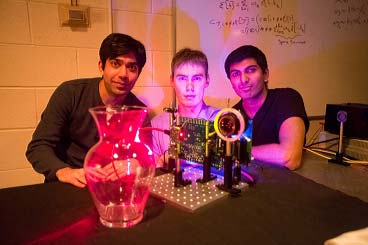A $500 “nano-camera” that can operate at the speed of light has been developed by researchers in the MIT Media Lab.
|
ADVERTISEMENT |
The 3D camera, which was presented last week at Siggraph Asia in Hong Kong, could be used in medical imaging and collision-avoidance detectors for cars, and to improve the accuracy of motion tracking and gesture-recognition devices used in interactive gaming.
The camera is based on “time of flight” technology like that used in Microsoft’s recently launched second-generation Kinect device, in which the location of objects is calculated by how long it takes a light signal to reflect off a surface and return to the sensor. However, unlike existing devices based on this technology, the new camera is not fooled by rain, fog, or even translucent objects, says co-author Achuta Kadambi, a graduate student at MIT.

MIT students (left to right) Ayush Bhandari, Refael Whyte, and Achuta Kadambi pose next to their “nano-camera” that can capture translucent objects, such as a glass vase, in 3D. (Photo: Bryce Vickmark)
…
Add new comment